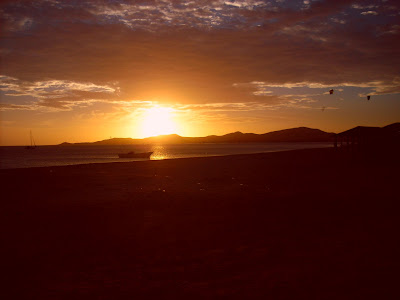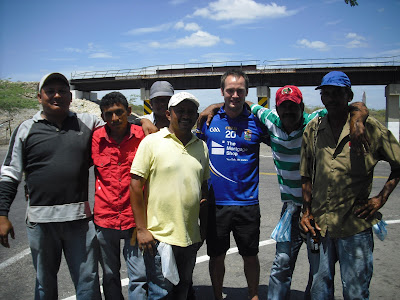For self-confessed inlanders, we do manage to spend a relatively nice amount of time on the coast when it comes to getting some rest and relaxation.
So after taking in parts of Colombia's secluded Pacific coastal region for our last 'voluntary' travels i.e. outside of visa renewals or specific events, this time around we headed back to the Caribbean, a part of Colombia we like to think we know very well.*
 |
| Sunset in Cabo de la Vela. |
That's largely based on the fact that we've been to the highlight city, Cartagena, on three separate occasions; taken in Sapzurro, Capurganá and Turbo (for more on the latter see http://bit.ly/SVtkWW); visited Santa Marta and stayed in Taganga; alongside travelling from Turbo via Cartagena to Maicao (that city's 'delights' are detailed here http://bit.ly/VG94Ho).
This time, however, we took in what might be described as a more tranquil side to this part of the country (the bustling port city of Santa Marta and the calmer Riohacha apart, that is — not that there is anything wrong with both places. They’re just bigger cities but have their own charms too).
 |
| Nice surprise. |
Palomino is described by many as Taganga of the 1990s; laid-back, reasonably priced and not very crowded with tourists.
Of course, there is a risk that this could all change, especially as more people discover its treasures. What might keep some people away, though, is a constant strong ocean current, meaning a relaxing dip in the sea is not an option.
However, with two river estuaries a short distance away, there are natural places to have a cooling-off swim, along with gentle tubing on offer down said rivers.
Being able to relax on a beach without a host of people constantly trying to sell you things was enough for us; throw in an unexpected photo shoot of a Colombian model right next to our sunbathing spot and we were more than happy with our time there.**
In fact, we enjoyed ourselves so much that we had two stints in the village, stopping in for a second time on the journey back from Cabo de la Vela.
Being able to relax on a beach without a host of people constantly trying to sell you things was enough for us; throw in an unexpected photo shoot of a Colombian model right next to our sunbathing spot and we were more than happy with our time there.**
 |
| Downtown Cabo de la Vela. |
For our first stop there we rented a hammock by the sea for $10,000 COP (roughly €4) per night.
On the return visit, a chance encounter with a hostel employee saw us spend four nights in a small dorm room in newly opened lodgings about a ten-minute walk from the beach, closer to the actual village. That cost $13,000 COP per night, with access to a modern, clean (very important that), well-equipped kitchen. ***
Now, while Palomino is certainly a chilled-out spot, the fact that it is just off the main road between the cities of Santa Marta and Riohacha ensures that it never feels completely cut off from the outside world.
Now, while Palomino is certainly a chilled-out spot, the fact that it is just off the main road between the cities of Santa Marta and Riohacha ensures that it never feels completely cut off from the outside world.
The same cannot be said for Cabo de la Vela.
Getting there is less straightforward, where asphalt roads give way to desert expanse making everything look pretty much the same. But like many of these secluded locations, the extra bit of effort (not that it’s that difficult) to get there is worth it.
For our own journey, even the required transfer stop at the nondescript Cuatro Vías de Maicao turned out to be an unexpected delight – four free beers (we’ll never say no to that) from the street vendors there while we waited for the next leg of the trip were well received in the hot midday sun.
The town of Cabo de la Vela itself is, unsurprisingly, quite basic with that tumbleweed-style feel to it.
 |
| Amigos. |
The town of Cabo de la Vela itself is, unsurprisingly, quite basic with that tumbleweed-style feel to it.
There are, we estimate, a few hundred residents – after a day it feels like you know all of them and they know you – and it gets plenty of tourists passing through, mostly in December and January.
However, this is still very much Wayuú territory; unlike some other remote Colombian resorts we’ve visited, the indigenous here are the dominant force and haven’t been pushed to the margins. Indeed, Spanish plays second fiddle to the Wayuú native tongue in these parts.
On the what-to-do front, relaxing while taking in the scenery and stunning sunsets are pretty much the chief activities.
 |
| A desert stroll. |
Pilón de Azúcar, a sacred seaside hill overlooking golden sand beaches, is a must to take in. It’s about a 40-minute walk from the town if you fancy stepping it out in the heat, just make sure you take plenty of liquid and cover yourself up well – our nonchalant approach to this was almost our downfall.
Alternatively, there are plenty of guys in ‘Cabo’ that will bring you there and back on a motorbike for a small fee.
The sport of kite surfing has found a suitable home here, with a never-ending strong gale blowing. There is also the option of taking a trip to Punta Gallinas, the furthest point north in South America.
The sport of kite surfing has found a suitable home here, with a never-ending strong gale blowing. There is also the option of taking a trip to Punta Gallinas, the furthest point north in South America.
It’s approximately a two-hour jeep ride to get there and relatively costly; hence, on our tight budget, it was something we passed on this time. We like to give ourselves an excuse or two to return to such places.
We found a couple of nights in Cabo sufficient on this occasion – perhaps with a partner in tow it might be worth sticking around a bit longer.
 |
| Atop of Pilón de Azúcar. |
Our early morning journey back to the transfer town of Uribia – the nearest urban centre – was memorable for the fact that it seemed to be goat-slaughtering day. Thus, we were joined in our packed jeep by a few crying goats, all four legs tied together, ready to be dropped (and chopped) off in Uribia. A man’s got to eat, we guess.
Returning to our inland abode of Bogotá was nice – we’re not going to disown it just yet – but this latest coastal adventure certainly gave us food for thought.
Returning to our inland abode of Bogotá was nice – we’re not going to disown it just yet – but this latest coastal adventure certainly gave us food for thought.
Just more examples of the plethora of treasures Colombia has to offer.
______________________
* See 'Lesser-spotted Colombia: Bahía Solano' at http://bit.ly/X3lWpV.
**For more on that photo shoot, visit http://www.revistadonjuan.com/galerias/andrea-escobar-el-angel-colombiano-de-victorias-secret/12993587/0.
***Hostal Urbe is the name of this place. It's located about three blocks off the main road heading towards the beach, down from the tienda 'Donde Leopoldo'.
______________________
* See 'Lesser-spotted Colombia: Bahía Solano' at http://bit.ly/X3lWpV.
**For more on that photo shoot, visit http://www.revistadonjuan.com/galerias/andrea-escobar-el-angel-colombiano-de-victorias-secret/12993587/0.
***Hostal Urbe is the name of this place. It's located about three blocks off the main road heading towards the beach, down from the tienda 'Donde Leopoldo'.
You sounded a right idiot on Liveline, wrong way indeed you tosser.
ReplyDeleteDon't came back, we don't need morons like you in Ireland anymore.
ReplyDeleteHi Anonymous. Thanks for taking the time to check out the blog and leave a 'message'.
DeleteWe imagine though that Ireland could do without more people making brainless, pointless comments who lack the courage to put their name to them.
I enjoyed reading that :) thank you!
ReplyDeleteI'm very happy that you did!
Delete